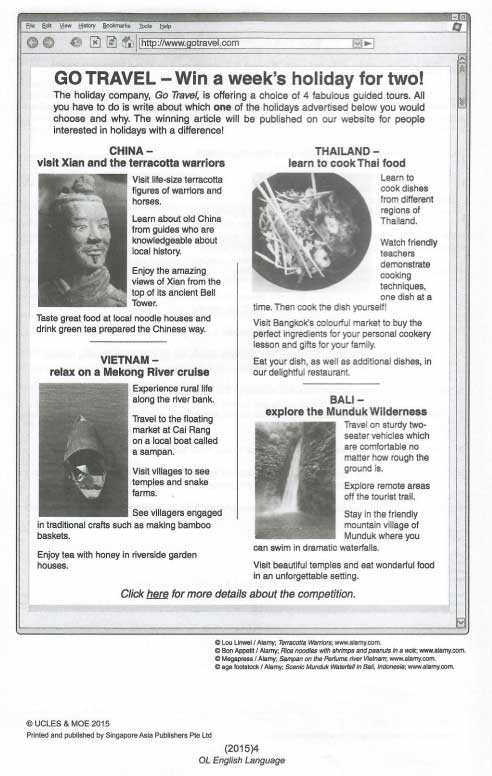In previous posts on how to write a good situational essay and using persuasive techniques, you’ve learnt how to tackle the informal letter/email and write a persuasive speech. As you’ve gone through your first or second year in secondary school, you’ve probably realised that the situational essay requires you to be versatile and apply the appropriate tone and style based on whom you’re writing to and for what purpose. While you adopt a more casual, friendly tone in the informal letter/email, you take on an engaging, inviting and sometimes witty approach in a speech.
In this post, you will learn yet another type — the feature article, which interestingly is a fusion of both the informal letter and the speech. Think of the travel articles you read about dream holiday destinations (very much a dream in recent times), or the film or drama reviews you come across on the Internet. These are examples of the feature article, written to engage, entertain and enthuse, prompting the reader to book that staycation or watch that film. To help you with this are 3 techniques — (1) using imperatives, (2) using vivid descriptions and (3) varying sentence structures, and they will be demonstrated with this question:
You have seen an advertisement* for a writing competition organised by the holiday company, Go Travel, and you decide to enter the competition. In your article you should explain the reasons for your choice of holiday.
Your article for the website must include the following content:
- a title to attract readers’ attention
- why the holiday appeals to you
- the activities available on the holiday
- what travellers will gain from the holiday experience.
Write your article for Go Travel’s website in clear, accurate English and in a lively, engagingtone to encourage readers to visit the destination you have chosen.
You should use your own words as much as possible. (2015 ‘O’ Level Paper 1 Section B)
*Copy of stimulus attached below

Applying the first ‘A’ (Analyse) from our first post, you can quickly gather that you are to engage and excite your readers about a holiday destination (Purpose), for potential holiday goers (Audience), in the form of an online article (Context).
Let’s learn how to use these 3 strategies to make your feature article more lively and engaging. For each of these strategies, you will see how an ordinary piece of writing can be transformed into a more appealing one.
How about writing your own “improved version” after reading the suggested example?
1. Use imperatives
Imperatives are basically “commanding verbs”, in that they compel the reader to do something. Some examples are “eat”, “pray” and “love”. You see marketing lines like this everywhere – on video or radio commercials, on online shopping sites and certainly on social media advertisements. Believe it or not, dropping phrases like “Enjoy a world of music at your fingertips” and “Snap a pair of airpods while stocks last!” does tempt you a bit more.
Here’s how you can apply this in your feature article:
Original:
When you visit Xian, China, you can witness life-size terracotta warriors and horses, which will give you a glimpse into China’s rich heritage. You also get to learn about old China from guides who are knowledgeable about local history. If you’re hungry along the way, there are local noodle houses and green tea prepared the Chinese way.
Revised:
Want a glimpse into China’s rich heritage? Visit Xian, China and witness life-size terracotta warriors and horses, and learn about Old China from guides who are well-versed in local history. If you find yourself hungry along the way, grab some traditionally made noodles, paired with green tea prepared the Chinese way!
Notice that the phrases in bold like “When you visit”, “you can witness” and “You also get to learn” have been shortened to imperatives like “visit”, “witness” and “learn” respectively. The plain “there are” phrase has also been tuned into an action, “grab”. This keeps your writing clean and packs more punch. Want to up the ante? Use rhetorical questions! (which you’ve learnt in Visual Text!) AN example is found in the first sentence of the revised version: “Want a glimpse into China’s rich heritage?”
2. Use vivid descriptions
You probably notice that other expressions have also been changed in the revised version of the above write-up. While you should be using your own words (e.g. synonyms), you need to use the second ‘A’ (Amplify) to elaborate, and that’s where you can spice up your article with vivid details.
Original:
ExperienceThai food from the different regions by learning to cook their signature dishes! Friendly teachers will first demonstrate cooking techniques at a conducive pace, and then you will try it out yourself. Don’t forget to buy the perfect ingredients for your cookery lesson at Bangkok’s colourful market before that!
Revised:
Experience the authentic, delectable flavours of Thai food from the different regions with a twist – learn to cook them yourself! At your service are friendly and engaging teachers who will guide you through the elaborate process of concocting the best sauces and picking choice ingredients for your dish. Your journey begins at Bangkok’s colourful market where you will be greeted with a myriad of tastes and smells bound to whet your appetite!
3. Vary sentence structures
While using imperatives is encouraged, they should be used sparingly and complemented by other techniques like (rhetorical) questions or conditionals (e.g. “If you…). Use a mixture of these structures to vary your sentences so they don’t sound repetitive, do flow better and create an engaging rhythm.
Original:
Visiting Bali allows you to explore the Munduk Wilderness! Travel on sturdy two-seater vehicles which are comfortable no matter how rough the ground is, or explore remote areas off the tourist trail. You also get to stay in the friendly mountain village of Munduk where you can swim in dramatic waterfalls.
Revised:
Walk on the wild side when you visit Bali! The Munduk Wilderness awaits you, with the grandeur of its dramatic, refreshing waterfalls and luxuriant foliage. If you’re tired from a trek through the rainforest, hire a sturdy two-seater vehicle which can speed you right back to the comfort of your mountain village abode. Feeling adventurous? Grab a map, trekking poles and a good pair of walking shoes and explore remote areas off the tourist trail!
Read both the original and revised versions out loud, and feel the difference. Which one sounds more exciting? Which one energises you? Varying your sentences is sure to keep your reader hooked and wanting more.
We have discussed 3 ways you can make your feature article more lively and engaging, by using imperatives – vivid, interesting ones; using vivid descriptions – like adjectives, metaphors; and varying sentence structures. With these strategies, you’re definitely more equipped to make your writing more exciting and appealing. For starters, why not try to write a short article featuring your favourite film, food or hobby – using the above techniques?
Check the other articles from this section
- Narrative Writing: Tips and Tricks
- Tackling the Situational Essay: Using persuasive speech techniques
- How to write a good Situational Essay: Analyse, Amplify and Apply the appropriate tone
- Lower secondary Writing Series 1 – E02: Narrative writing (or how to write good essays)
- Lower secondary Writing Series 1 – E02: Narrative writing practice
- Lower secondary Writing Series 1 – E03: Expository writing
- Lower secondary Writing Series 1 – E01: How to analyse essay questions
- Lower secondary Writing Series 1 – E04: Hybrid writing
- Taking the Leap from Primary to Secondary English with Confidence!
- Secondary English Paper 1 components: Diagnosing your strengths and weaknesses
- Lower secondary Writing Series 1 – E05: Avoiding writing pitfalls
- From primary to secondary English: What’s new and challenging?
- Post-Exam Reality Check in 3Rs
- A Sneak Preview of the Secondary English Writing in the Sec 2 class
- Secondary 2 English – Editing through clue-finding
- Secondary 1 English: An introduction on how to create interesting characters
- Sec 2: 5 tips to help you write great English expository essays
- Discursive essay: Writing a well-developed body Paragraph
- 3 tips for tackling the summary Question
Don’t Miss Any Future Post!
2024 Bukit Timah Branch Secondary English Tuition Timetable
| Level | Class Type | Day | Time |
|---|---|---|---|
| S1 | All Components Class | SAT | 5 pm to 7 pm |

